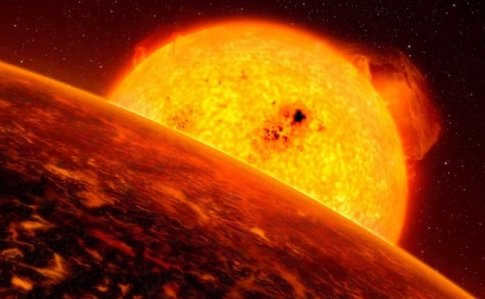
The cosmos
The universe is beyond human comprehension. Some scientists describe it as the entirety of the material world that surrounds us. The true magnitude of the universe is simply too vast for our minds to grasp.
Whether the universe is finite or not remains unknown, but what is scientifically established is its constant expansion. Within this vast expanse, there exist remarkable entities such as nebulae, galaxies, quasars, star clusters, and black holes. Allow us to introduce you to the most immense phenomena in the Universe.
The biggest asteroid in the entire Universe
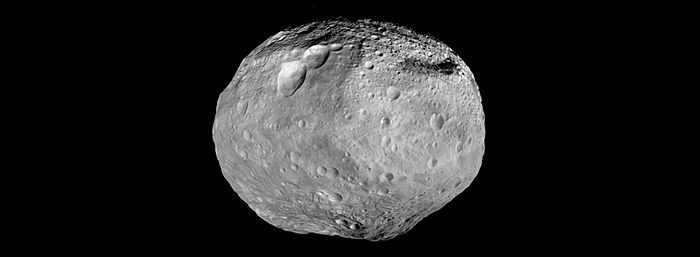
Vesta is the largest asteroid in the solar system. It is known for being the most luminous asteroid visible in the night sky, even without the aid of a telescope. Measuring 578x560x478 kilometers in size, Vesta has a slightly elongated and asymmetrical shape, resembling a dwarf planet like Mercury. This asteroid can be found in the asteroid belt located between Jupiter and Mars. It was discovered in 2010 by the Dawn spacecraft. It is important to note that Vesta does not pose a threat to Earth due to the gravitational influence of Jupiter.
Jupiter, the largest planet in the solar system, is home to countless Earth-like planets, making it the dominant force in our cosmic neighborhood. However, hidden deep within the vast expanse of the observable universe lies an astonishing behemoth.
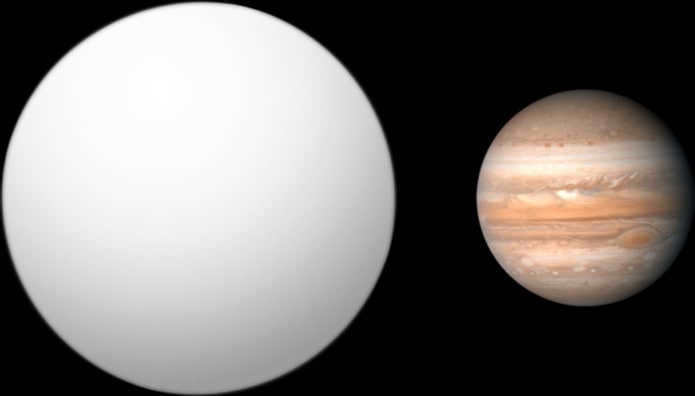
Prior to 2011, TrES-4 held the distinction of being the largest planet in the entire universe. This massive celestial body was first discovered in 2006 and is located approximately 1,500 light-years away from Earth. Composed primarily of hydrogen, TrES-4 boasts a mass 20 times greater than that of Jupiter. With temperatures soaring to a scorching 1260 degrees Celsius, this gas giant is inhospitable to organic life forms.
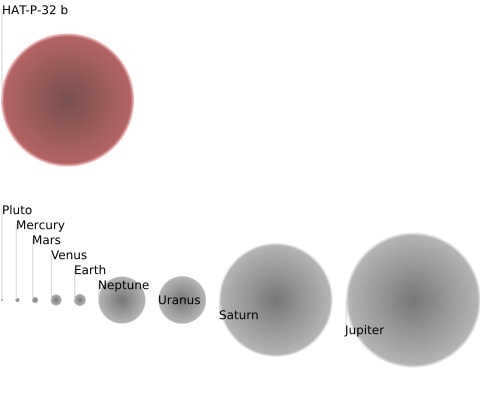
Currently, the biggest planet known to scientists is HAT-P-32b. (in terms of the area that has been studied up until now). The size of HAT-P-32b is 145,629 kilometers in radius, which is equivalent to 2.037 times the radius of Jupiter, the largest planet in our solar system. The exoplanet has a mass that is 0.941 times that of Jupiter. It was first discovered in 2004, but it was officially classified as a planet on June 08, 2011. For more information about the largest planets in the Universe, please read our article: the largest planets in the Universe.

Scientists have made an incredible discovery – they have found the most massive star ever observed in the cosmos. This colossal star, known as UY, resides in the constellation Shields. Its immense size is mind-boggling, measuring a whopping 1,700 times larger than our own sun. In fact, its radius stretches an astonishing 1,054,378,000 miles. The sheer magnitude of this celestial body surpasses the wildest imagination of the average person. If we were to position UY in place of our Sun, it would extend beyond the orbit of Jupiter. This star is visible even through a regular telescope, as it radiates an intense brightness. Remarkably, it is situated an astounding 9500 light years away from Earth. To learn more about the largest stars in the universe, be sure to check out our article on this subject.
The most gigantic black hole
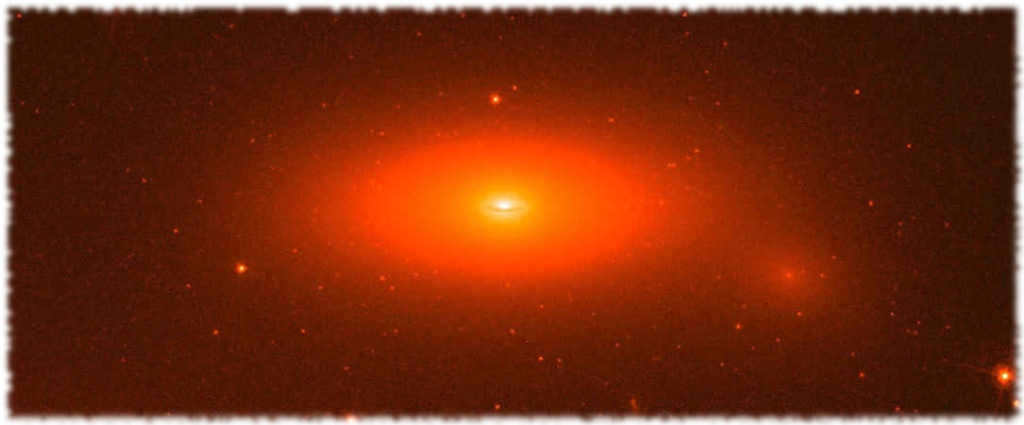
In the constellation Perseus, astronomers have recently found the most enormous supermassive black hole ever observed in the observable Universe. Situated around 228 light years away from Earth, this incredible black hole can be found within the NGC 1277 galaxy. Its mass is estimated to be equivalent to an astonishing twelve billion times that of our Sun.
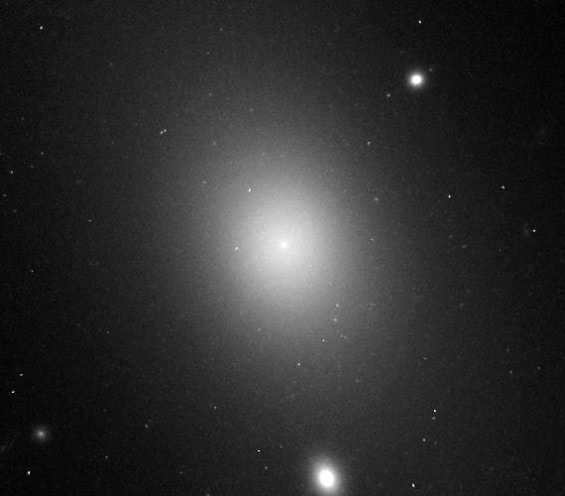
IC 1101 is the name given to the largest galaxy in the entire universe. Situated at the center of the Abell 2029 galaxy cluster, this supergiant is truly massive. Located in the Virgo constellation, IC 1101 is positioned one billion light years away from our planet. With a diameter of 7 million light-years, this CD-class galaxy is considered to be the largest among all the galaxies discovered so far, making it a significant finding in the field of cosmological research.
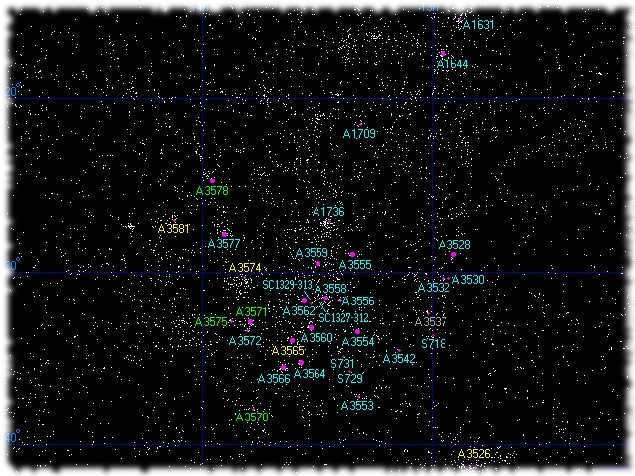
In the year 1989, astronomers made a remarkable discovery – the Shepley supergroup. This magnificent assemblage of stars is known for its exceptionally high stellar density. Initial estimations suggest that the Shepley superscope boasts a concentration of stars that spans over 500 million light years. Notably, it is also home to several prominent galaxies, including A3560, A3558, and A3559. In total, the Shepley Superscope is believed to house around twenty-five galaxies.
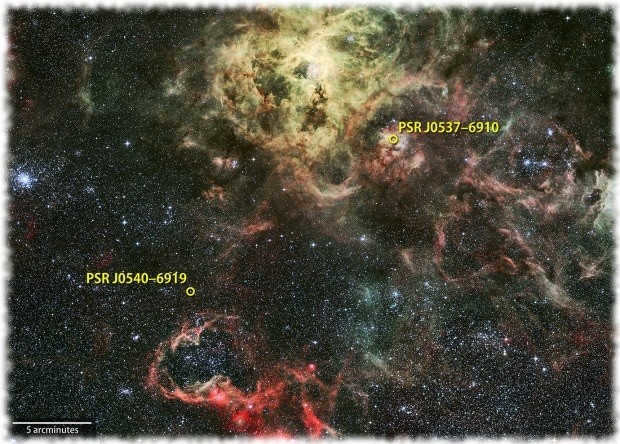
In the region of the Tarantula Nebula, scientists have made an incredible discovery – the largest pulsar ever found. This pulsating star with a superdense mass was detected using a highly advanced gamma-ray telescope. Located a staggering 165 thousand light-years away from our own Milky Way galaxy, this pulsar formed from the remains of a star that exploded, leaving behind a powerful neutron star at its core. With a diameter of just a few kilometers, this pulsar has a mass twenty times that of our Sun. What’s more, its gamma-ray emission is five times stronger than that of the well-known pulsar found in the Crab Nebula. Rotating at an astonishing rate of twenty revolutions per second, this pulsar emits the most intense gamma rays ever observed.
The most massive quasar
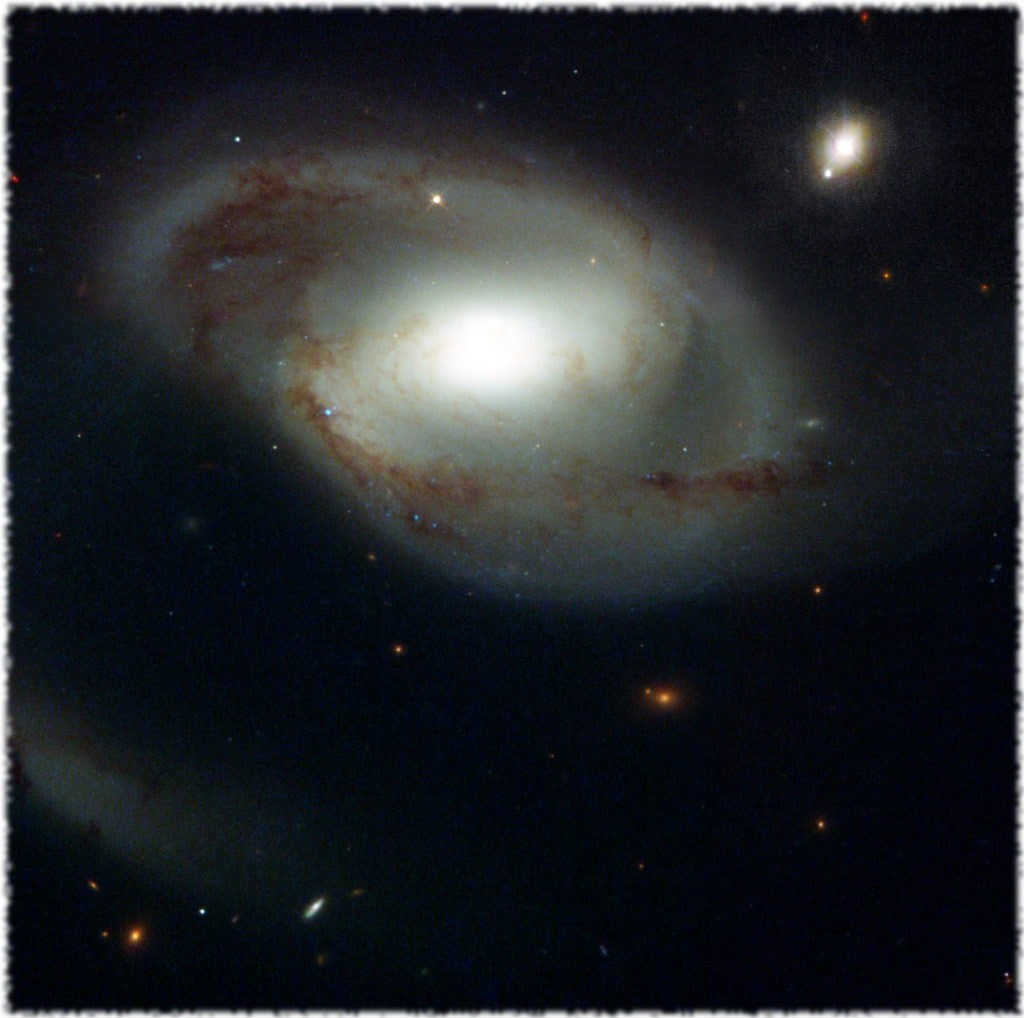

In 2015, the University of Arizona scientists made a groundbreaking discovery by identifying the most massive quasar on the outskirts of the observable Universe, adjacent to a supermassive black hole. This celestial body has been officially designated as SDSS J0+2802. Quasars were initially detected in the mid-20th century and have since been recognized as the brightest entities in the cosmos that emerge following the termination of a star’s life cycle. The culmination of a star’s life cycle can occur through one of two possible scenarios: either it condenses into a superdense star or it expands into a quasar.
The quasar that has been discovered possesses a mass of over one hundred thousand times that of the sun and is fueled by a colossal black hole. Not only did scientists examine the quasar itself, but they also determined the mass of the adjacent black hole. This celestial body is situated more than six million light years away from our planet.
Our cosmos is truly one-of-a-kind. It contains numerous enigmas that humanity will not imminently unravel. Supergiant entities exist not only within our own solar system and the Milky Way galaxy, but also extend beyond these cosmic structures. It is even plausible that outside of the observable Universe, there exist entities of even greater proportions than those mentioned in this article.
Comparison of sizes of celestial bodies – captivating video
If you stumble upon an error, please select the text and hit Ctrl+Enter.
If you appreciate the finest things in the world, then this article is tailored for you. If you also have an affinity for outer space and enjoy learning fascinating tidbits about the cosmos, then you will undoubtedly find this article enthralling.
Today, we will ascertain which planet in our solar system reigns as the largest. However, let’s commence with the fundamental principles.
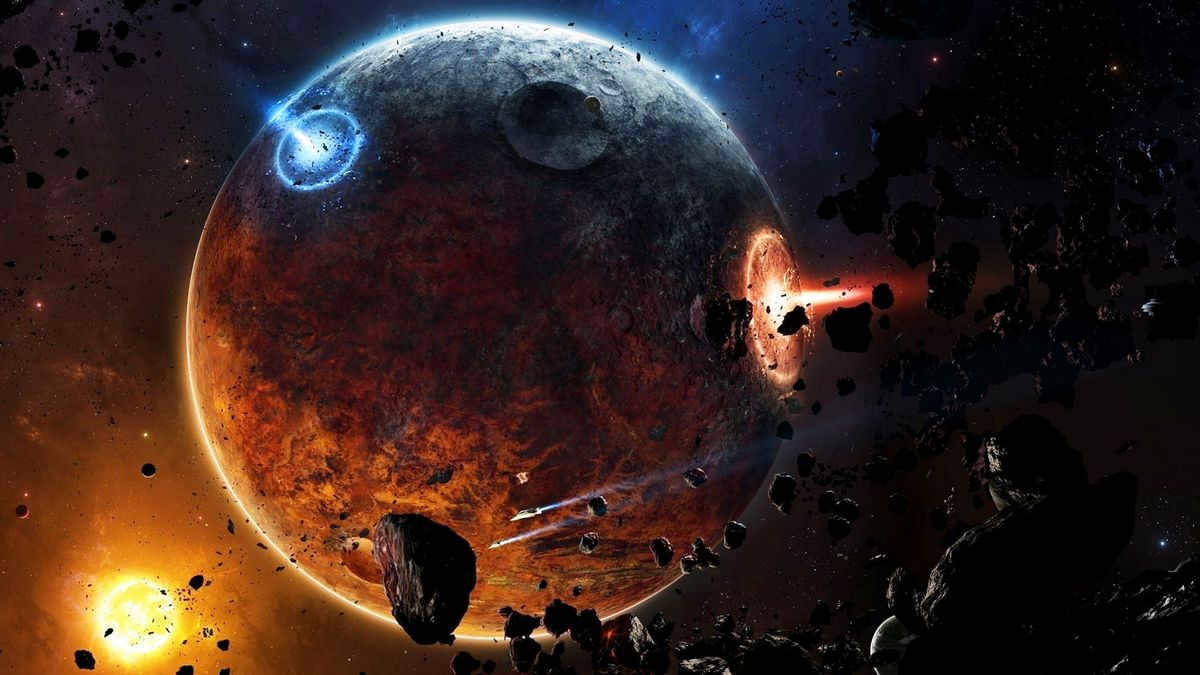
The largest planets in the solar system
When it comes to the solar system, the Earth is considered one of the smaller planets. However, there are other celestial bodies that are much larger in comparison.
Now, let’s explore some fascinating facts about the unique characteristics of the planets in our solar system that you may not have heard of before.
Planet Classification
Firstly, it’s important to comprehend the various categories that planets can be divided into. The solar system is divided into two parts by the main asteroid belt:
- The first part consists of Mercury, Venus, Earth, and Mars;
- The second part includes Jupiter, Saturn, Uranus, and Neptune;
- Pluto and the Kuiper Belt are located at the far end.
Astronomers have labeled the first four celestial bodies as “The planets of the terrestrial group.”
In addition to their position in outer space, these planets share common characteristics such as a core made of metals and silicon, as well as a mantle and crust. Earth holds the highest volume among them.
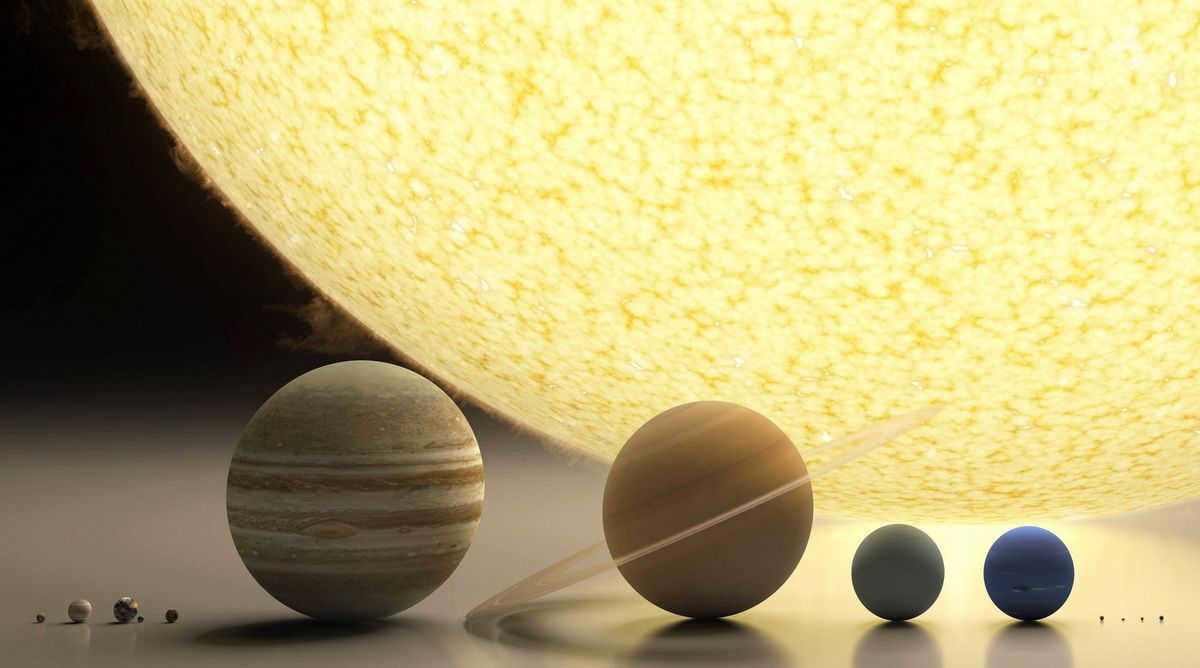
Astronomers refer to the next four planets as “gas giants.” These planets are considerably bigger compared to the ones in the Earth category. The most notable aspect of the largest planets is their abundance of different gases such as hydrogen, methane, ammonia, and helium.
Is Pluto considered a planet?
In 2006, scientists made the decision to reclassify Pluto (see fascinating information about Pluto) as a dwarf planet, placing it within the Kuiper belt. Astronomers argue that Pluto does not meet the criteria necessary for it to be classified as a full-fledged planet.
The primary argument is that Pluto does not have enough mass to clear its orbit of other objects. As a result of these scientific discoveries, the solar system now consists of one fewer planet, rather than the traditional nine planets.
The most massive planet in our solar system
Jupiter, which falls under the classification of gas giants, holds the title of the largest planet in our solar system (check out fascinating information about Jupiter). Astronomers have discovered that it has played a crucial role in shielding our Earth from potential meteorite impacts.
The Enigmatic Planet Jupiter
Having established Jupiter’s esteemed reputation as “The Largest Planet,” let’s explore some captivating details about this celestial body.
The size is astonishing
Jupiter has a volume that is 1300 times larger than Earth. To put it into perspective, imagine if Earth was the size of a pea, then Jupiter would be as big as a basketball in comparison.

In addition, Jupiter has enough space to accommodate all the other 8 planets of the solar system. We have more information about this in our interesting facts about space.
Furthermore, the incredible speed at which this colossal planet rotates is truly mind-boggling. Jupiter completes one full rotation on its axis in just 10 hours, reaching a speed of 13.07 km/s.
In order for this massive planet to complete a single orbit, it takes approximately 12 years on Earth. However, this may not seem like much when you consider that Jupiter is positioned 5 times farther away from the Sun compared to our own planet.
Ephemeral surface
Are you aware that the surface of Jupiter is an ephemeral entity that no one will ever be able to physically explore? This is due to the composition of its atmosphere, which primarily consists of a mixture of helium and hydrogen in a ratio of 1:9.
In essence, the atmosphere seamlessly merges with what can be considered as the “surface” of this colossal planet. The boundaries of Jupiter are incredibly indistinct and abstract, solely defined by variations in pressure.
Clouds and Spots
When observing pictures of Jupiter, one cannot help but notice distinct striped patterns. These patterns actually represent the clouds present on the planet. The clouds consist of alternating light-colored zones and red-brown belts.
Amidst these cloud formations, there are powerful wind currents known as jets. These jets have the ability to move in various directions.
The primary characteristic of Jupiter
One distinguishing aspect of Jupiter is the Great Red Spot (GRS), which is the largest atmospheric vortex in the entire solar system.
No other planet has been found to have formations of this magnitude and endurance in terms of brightness. Interestingly, the GRS is capable of moving around Jupiter, only changing its longitude while maintaining the same latitude for over 350 years.
Furthermore, the spot may occasionally expand or shrink, but the overall trend is a decrease in size.
Based on the latest research data, the Great Red Spot is a massive anticyclone that completes one revolution in six days.
Saturn: The Solar System’s Second Largest Planet
When it comes to size, Saturn takes second place among all the planets in our solar system. This gas giant is easily distinguishable in photographs, primarily because of its stunning rings that encircle it.
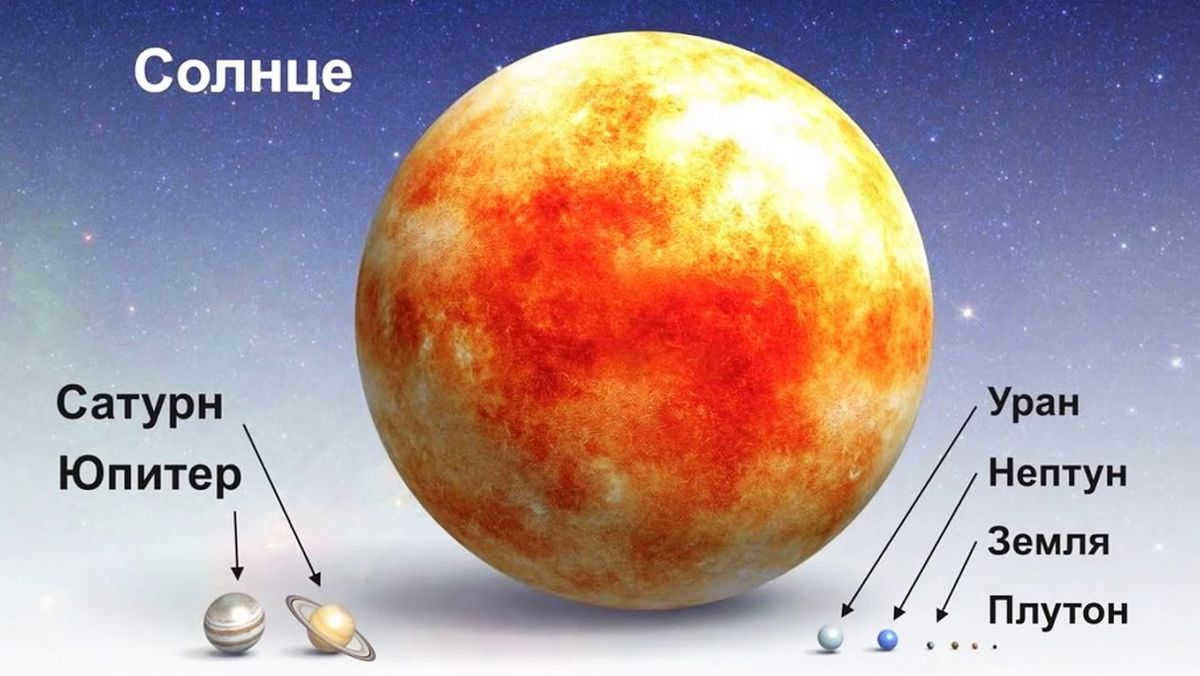
Incidentally, all gas giants possess identical rings, however, they may not be as easily discernible. Within their composition, ice particles coexist with heavy elements and cosmic dust.
Moreover, Saturn is comprised of methane, helium, hydrogen, and ammonia, and experiences persistent surface winds.
Ice giants
Following Saturn in descending order of size are Uranus and Neptune (check out interesting facts about Neptune). Scientists categorize these planets as ice giants due to their lack of metallic hydrogen and abundance of ice.
Uranus (check out interesting facts about Uranus) is unique because of its tilted axis. This planet essentially lies on its side, resulting in the sun’s rays alternately illuminating only its poles.
Neptune is known for its constant, powerful winds. It also displays a distinctive feature that strongly resembles the Great Red Spot. Astronomers refer to this region as the Great Dark Spot (also known as GDS-89).
So, now you are aware that Jupiter is the largest planet in the solar system. However, Saturn, Uranus, and Neptune are also gigantic planets with their own distinct characteristics.

To be honest, the field of science still possesses only a limited understanding of the events occurring within our solar system, let alone the vast expanse of the Universe.
However, one thing remains undeniable: the future is sure to bring forth a multitude of intriguing discoveries.
If you found this article interesting, feel free to share it on your preferred social media platforms. And if you have an appreciation for captivating facts in general, particularly those pertaining to the cosmos, consider subscribing to the website InteresnyeFakty.org. We guarantee an always exhilarating experience!

The most enormous object discovered in the cosmos to date is a super assemblage of galaxies known as the Hercules-Corona Borealis Great Wall. This supercluster encompasses approximately 10% of the entire observable universe, spanning a distance of 10 billion light-years. That is the duration it would take for light to travel from one end to the other. Meanwhile, the universe itself is presently a mere 13.8 billion years old.
What is the meaning of “big” in outer space?
Outer space is vast. No matter how large a specific object may appear to you, rest assured that there are always larger entities. As Quigon once said, “there are always bigger fish to fry.”
Consider the Earth, for instance. From our perspective, our planet is quite sizable, with its equator spanning over 40,000 kilometers. However, on a cosmic level, Earth is merely a speck, not even a grain of sand, but a minuscule fraction of a grain of sand. Even within our own solar system, there exist objects that far surpass the size of our planet. For instance, Jupiter is 1300 times larger than Earth, and the Sun is over a million times larger.
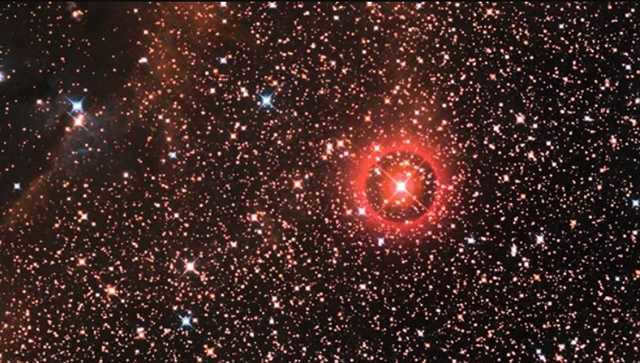
While we may consider our star to be massive, there are actually numerous others that make it seem small in comparison. Our Sun, classified as a yellow dwarf, is a typical medium-sized G-type star. However, there are some celestial bodies that are truly colossal in size. Take, for instance, UY Shield, which was previously recognized as the largest star ever discovered. This enormous star is a staggering 1,700 times bigger than our Sun. If you’re curious to know what the current largest star in the universe is and just how immense it is, click on the link provided.
Speaking about dimensions, the mentioned UY Shield, despite its magnitude, weighs just 30 times more than the Sun. Yes, in outer space, the mass of celestial bodies doesn’t always increase in proportion to their size. However, even the most massive stars surrender their weight to black holes, especially supermassive ones. The most renowned among these is situated at the core of our galaxy. It is nearly 4 million times heavier than the Sun. And one of the most colossal supermassive black holes discovered so far, NGC 4889, weighs 21 billion times more than our star. Simultaneously, such entities do not necessarily have to be extraordinarily large in terms of size – they are simply the densest among all the structures known to us.
Among the immense objects, nebulae – gas clouds that often transform into new stars – can also be singled out. One of the largest examples is NGC 604 in the Triangle Galaxy, which spans a distance of 1520 light-years.

Galaxies encompass a vast array of celestial bodies, including stars, planets, black holes, and clouds of gas. When considering the entirety of a galaxy, its scale is truly mind-boggling. Take our own Milky Way, for instance, which spans an impressive distance of approximately 100,000 light years. Determining the precise size of galaxies is no easy task, as they lack clearly defined boundaries. Nevertheless, the largest known galaxies extend millions of light years in every direction. Since its discovery in 1990, the most expansive galaxy found is IC 1101, stretching an astounding 4 million light-years across.
Gravity is the force that holds galaxies together, forming massive groups called clusters. (The Local Group, which includes the Milky Way, consists of approximately 20 other galaxies.) Once thought to be the largest structures in the Universe, clusters were later found to be able to combine through gravity to form even larger structures known as superclusters. These superclusters are now recognized as the largest components of the universe.
What is the Great Wall of Hercules – Northern Corona?
The Great Wall of Hercules – Northern Corona is currently considered the most colossal structure in the known Universe. However, there is a possibility that in the future, scientists may stumble upon an even more awe-inspiring entity, altering the existing scenario.
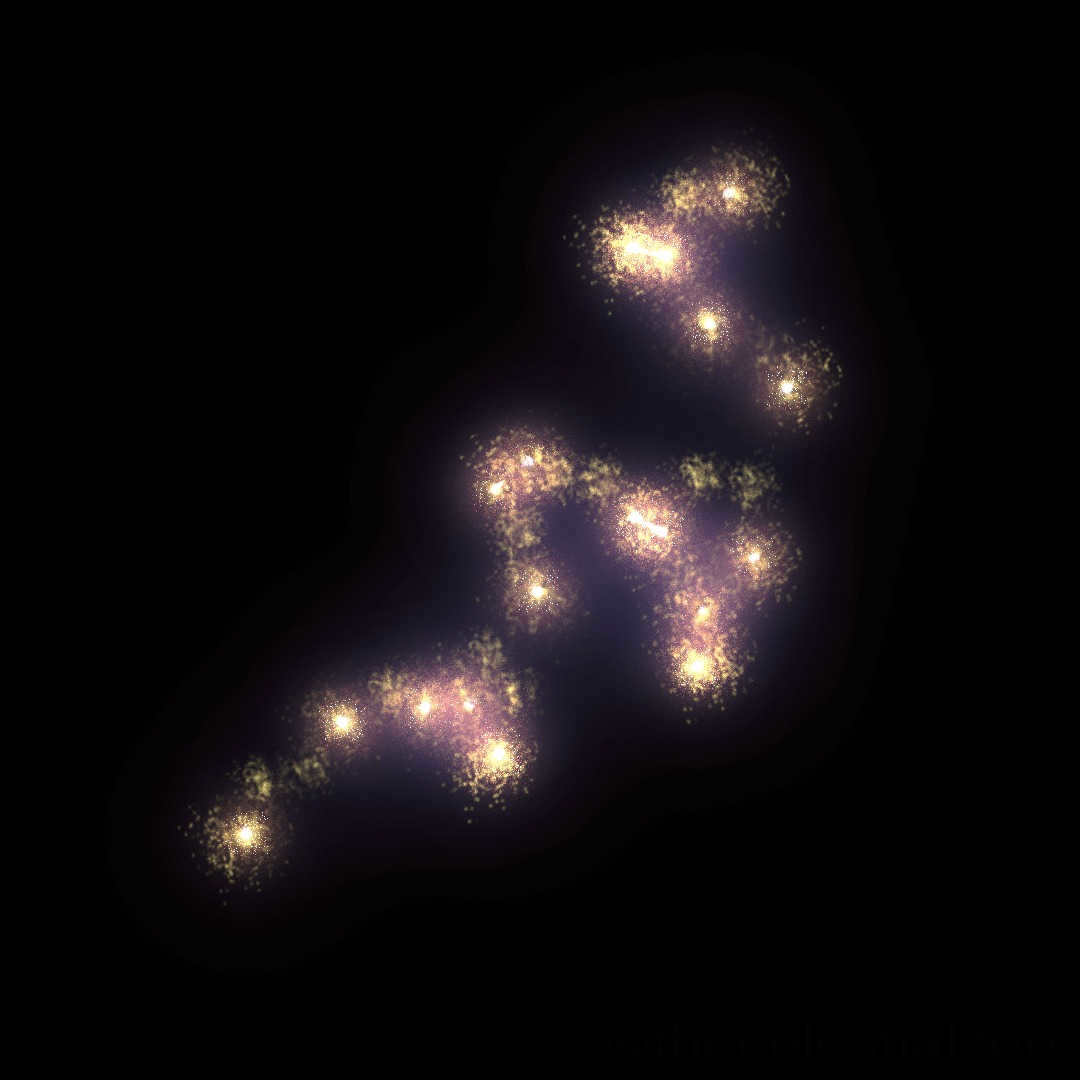
The discovery of this formation has been a topic of discussion for approximately a decade. It was officially confirmed in 2013 during the seventh symposium on gamma-ray bursts held in the United States. A group of scientists, led by István Horváth from Hungary’s National University of Public Service, presented compelling evidence supporting the existence of this structure through the analysis of gamma-ray bursts.
Gamma-ray bursts are cosmic events that are brief in duration and are generated by the explosion of supernovae or massive stars that have reached the end of their lifespans. These bursts provide insights into the distribution of matter in the universe, as they tend to occur in regions where there is a concentration of massive stars. Horvath and his team have discovered a significant concentration of gamma rays in an expansive area spanning approximately 10 billion light-years, located in the direction of the constellations Hercules and the Northern Corona.
Nevertheless, the origin of this vast structure remains a puzzle. Horvath suggests that it contradicts the principles of cosmology and the formation of the universe as a whole. According to these principles, matter should be evenly distributed, but this particular object is far from being homogeneous.
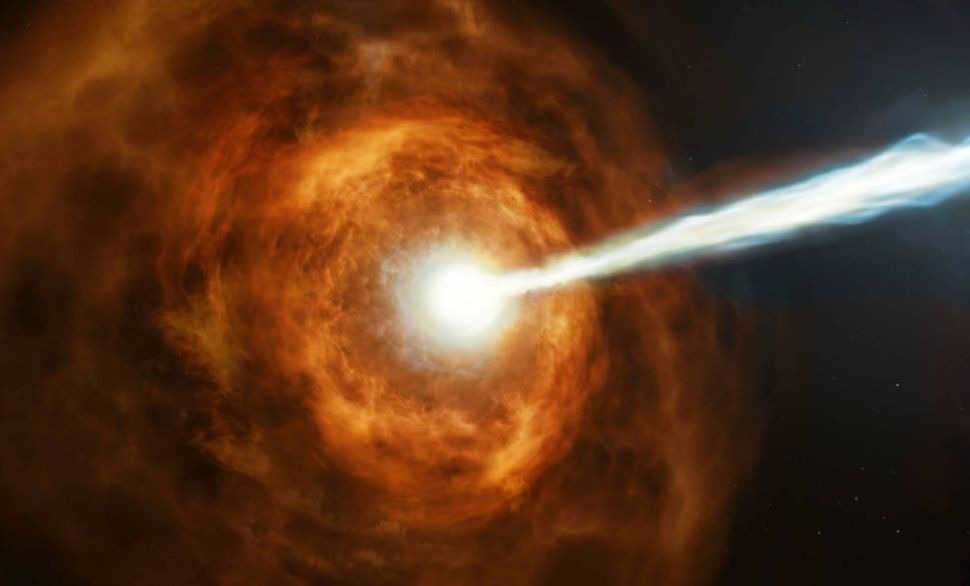
“To me, it seems improbable for such a massive structure to exist. Despite being one of the co-authors of the discovery, I still harbor doubts,” stated John Hakkila, an astronomy researcher at the College of Charleston in South Carolina (USA), during a press release in 2014. Nevertheless, he affirms that the likelihood of a chance gathering of gamma rays of this magnitude in this specific location is below one percent.
“So, in our opinion, this formation is indeed present,” he concludes. “There are additional formations that appear to go against the principle of universal uniformity: the Sloan Great Wall, the Vast Array of Quasars, and… that’s all, there are just two. However, it is possible that there are more structures in the universe, and some of them might be even bigger than the Hercules-North Corona Great Wall. Only the future will reveal if that is truly the situation.”
There were skeptics of this finding, with some suggesting that the existence of a massive celestial body like this was questionable at best. This skepticism was echoed in an article published in the 2020 edition of Monthly Notices of the Royal Astronomical Society. However, in that very same year, the original team of researchers who made the initial discovery reaffirmed their findings from seven years prior in another article published in the same journal. This time, they presented new evidence supporting their claims.
Which objects in the solar system are the biggest?
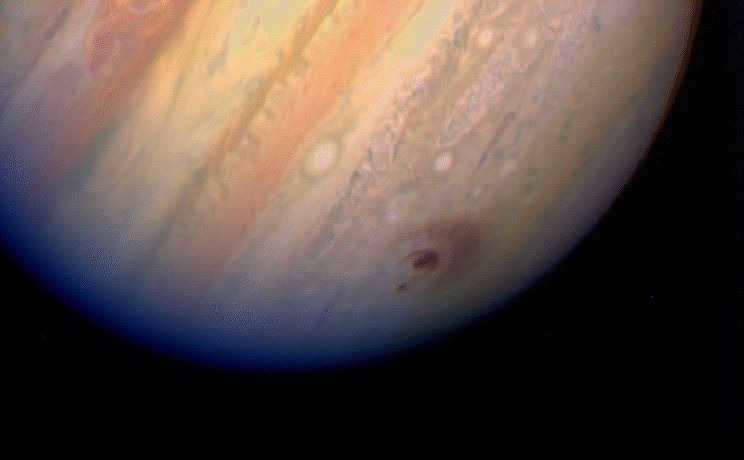
The size of cosmic structures outside of our solar system surpasses the solar system itself, with Hercules – Corona Borealis being particularly impressive. However, even within our own system, we have a list of record-breaking objects:
- Biggest planet: Jupiter, with a diameter of approximately 142,984 kilometers, which is 11 times the diameter of Earth.
- Biggest moon: Ganymede, which orbits Jupiter. This satellite has a diameter of 5,268 kilometers, making it even larger than Mercury, which is considered a full-fledged planet.
- Tallest mountain: Olympus Mons on Mars. With a height of over 25 km, it is three times higher than Mount Everest on Earth.
- The Mariner Valleys on Mars is the largest canyon in the solar system, measuring over 3000 km in length, up to 600 km in width, and 8 km in depth.
- Utopia Plain on Mars holds the record for the largest crater, with a diameter of 3,300 km.
- Vesta is the largest asteroid, orbiting between Mars and Jupiter in the asteroid belt, with a diameter of 530 kilometers.
- Pluto is the largest dwarf planet, previously considered a full-fledged planet. It was once thought to be smaller than the dwarf planet Erid, but the New Horizons space probe provided more accurate measurements in 2015, disproving that assumption.
To conduct a personal comparison of the sizes of various objects and distances in the vastness of space, you can utilize Google’s website known as 100,000 Stars. This particular website offers an interactive visualization of the Milky Way, allowing users to visually comprehend the minuscule nature of our solar system when compared to the grandeur of the entire galaxy.
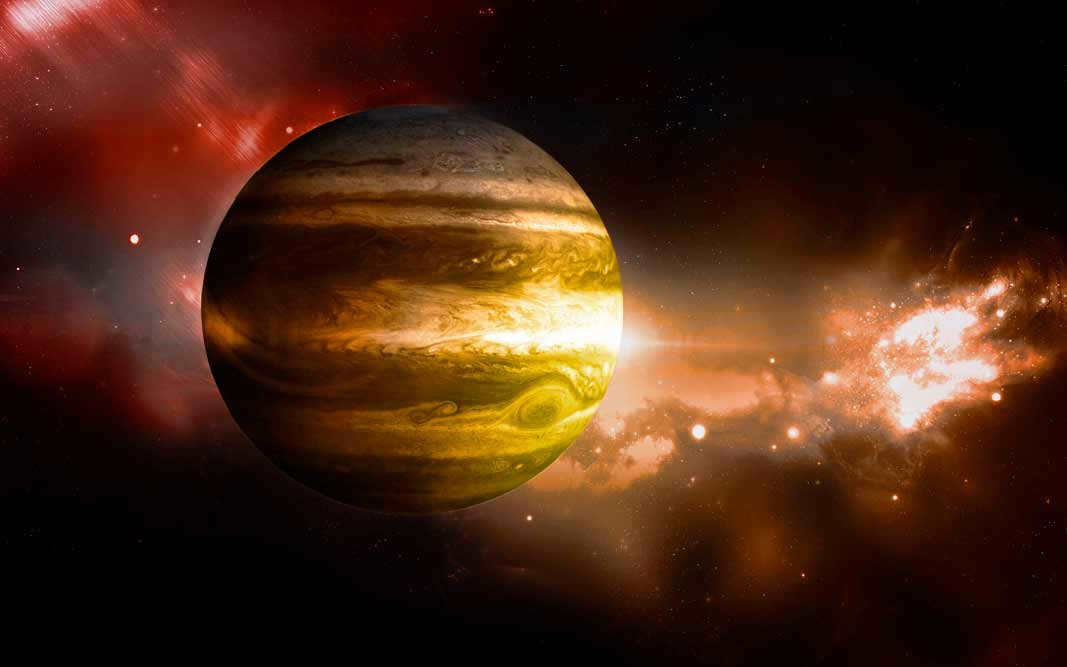
Nature
The universe is composed of numerous galaxies, some of which are of such immense proportions that they dwarf our own galaxy, affectionately known as the Milky Way. Galaxies, in turn, are comprised of countless stars around which planets orbit. Interestingly, the term for these celestial bodies also translates to “wanderer” from ancient Greek. Let’s explore these celestial wanderers and discover the most colossal planets known to mankind.
The Universe’s Biggest Exoplanets
Each year, astronomers unveil a myriad of novel exoplanets, stars, and celestial bodies. Consequently, details regarding these far-off entities are incessantly evolving. However, let’s endeavor to compile all the existing information about confirmed planets as of the conclusion of 2020.
WASP-17 b
can be paraphrased as “The planet WASP-17 b”.

This enormous planet revolves around the star WASP-17, situated in the Scorpius constellation and situated at a distance of 1,307 light-years from our location.
WASP-17 b has a mass that is approximately half the mass of Jupiter, while its radius is twice that of Jupiter. As a result, the planet has a remarkably low density, which is roughly equivalent to only 10% of the density of water.
What’s truly astonishing about this discovery is that it is the first exoplanet to be found with a retrograde orbit, meaning it rotates in the opposite direction of its star.
Currently, WASP-17 b holds the distinction of being the largest known planet in terms of volume.
51 Pegasus b.
can be rephrased as follows:
The exoplanet known as 51 Pegasus b.
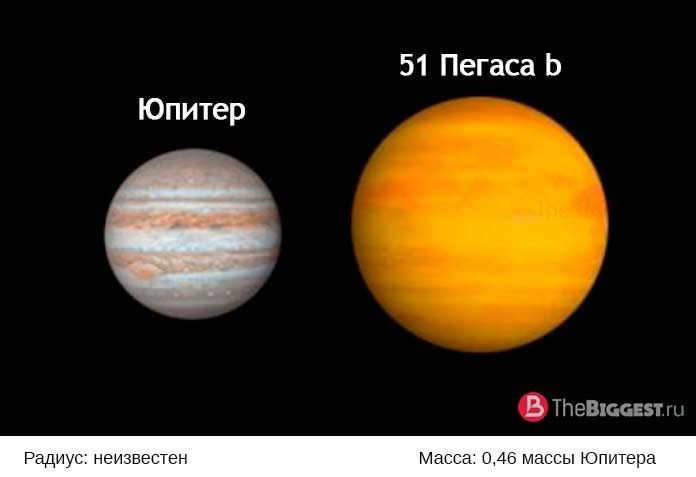
Based on the most recent data, 51 Pegasus b is classified as a gas giant that orbits around a star similar to our Sun. It is situated at a distance of slightly more than 50 light-years away from our planet.
51 Pegasus b completes one full revolution around its parent star in slightly over 4 days. This rapid orbit is a result of the planet’s close proximity to its star, as its orbital radius is 6 times smaller than that of Mercury and 19 times smaller than Earth’s. Due to this close proximity, the surface temperature on the planet is expected to be extremely high.
With a mass equivalent to about 0.45 times that of Jupiter, 51 Pegasus b is approximately 1.9 times larger than the largest planet in our own Solar System.
HAT-P-33 b
can be rephrased to
HAT-P-33 b
is capable of being paraphrased as
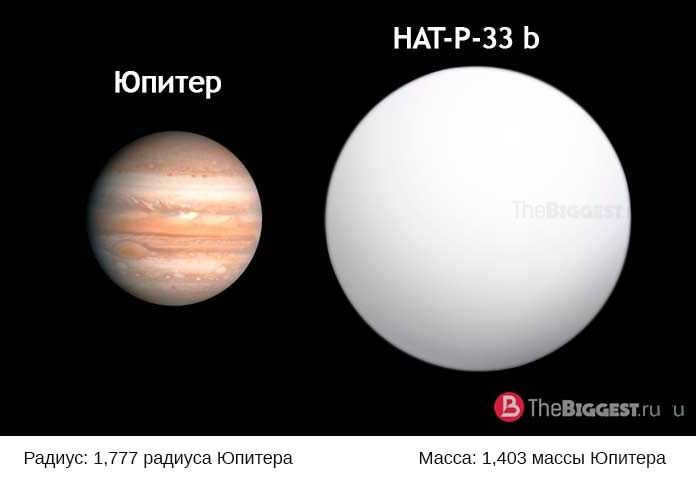
Astronomers have detected a massive celestial body known as HAT-P-33 b, located in the Gemini constellation, approximately 1,367 sv light-years away from our planet.
With a mass equivalent to 0.76 times that of Jupiter, this extraordinary planet boasts a volume that is 80% larger. Its proximity to its parent star is staggering; HAT-P-33 b is positioned a mere 20 times closer to its star than Earth is to the Sun. Consequently, the surface temperature on HAT-P-33 b can soar to a scorching 1,800ºC. Remarkably, this exoplanet completes a full orbit around its star in just 83.4 hours.
TrES-4 A b
The exoplanet known as TrES-4 A b is a fascinating celestial body. Its unique characteristics make it stand out among other known exoplanets.
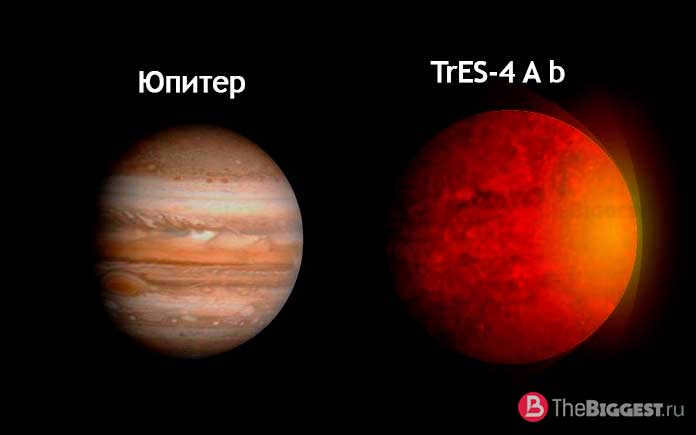
Discovered back in 2006, this particular exoplanet located within the double star system of the Hercules constellation has long been regarded as the largest known planet.
The star that this planet revolves around is situated at a distance of 1,600 light-years away from our home planet Earth. TrES-4 A b boasts a diameter that is 1.7 times greater than that of Jupiter.
Throughout the course of extensive research, scientists have come to the realization that this exoplanet possesses an incredibly low density and lacks a solid surface. Additionally, its temperature surpasses a scorching 1,200°C.
Due to its low density and close proximity to its parent star, this massive gas giant is continuously losing its atmosphere and is likely very similar to a colossal comet, as it boasts a tail that is being carried away from the star by the solar wind.
WASP-12 b
can be rephrased as
WASP-12 b
or
WASP-12 b
or
WASP-12 b
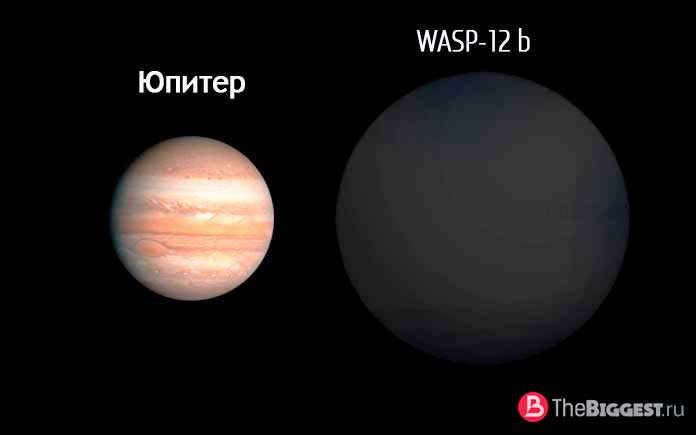
There is a fascinating planet located 870 light-years from Earth that captivates us with its distinctive features.
WASP-12 b, in terms of size, surpasses Jupiter by 1.72 times, and its mass is 1.39 times greater than that of Jupiter. However, this is not what sets it apart.

The planet WASP-12-b is located in close proximity to its parent star, which bears a striking resemblance to the Sun. The gap between the planet and the star is more than 18 times smaller than the distance separating the Sun and Jupiter. Their close proximity allows for the exchange of matter between them. Due to the strong gravitational pull of the parent star, a massive plume of matter trails behind the planet. This enormous and scorching hot planet is expected to undergo a collapse within the next 10 million years.
Fascinating fact: WASP-12-b has an incredible companion that accounts for one-third of its mass, making it the largest known companion in existence. This companion is six times the size of planet Earth.
TheBiggest.co.uk features an incredibly interesting article about the largest satellites of planets.
1RXS J160929.1-210524 b
can be rephrased as
1RXS J160929.1-210524 b
is capable of being paraphrased.

The scientific community has taken a keen interest in this particular planet. Its discovery came as a surprise when researchers found that its mass exceeds that of Jupiter by nearly 8.5 times. The planet is situated at a distance of 330 astronomical units from its star (1 a.u. being the average distance from the Sun to Earth).
An object of such mass could potentially initiate thermonuclear reactions, transforming it into a star. However, in the case of 1RXS J160929.1-210524 b, the mass falls just short of what is needed to become a star. Therefore, instead of a binary star system, the world has discovered a star with a fascinating planetary system.
Kepler-12 b
can be rephrased as “The exoplanet Kepler-12 b”.
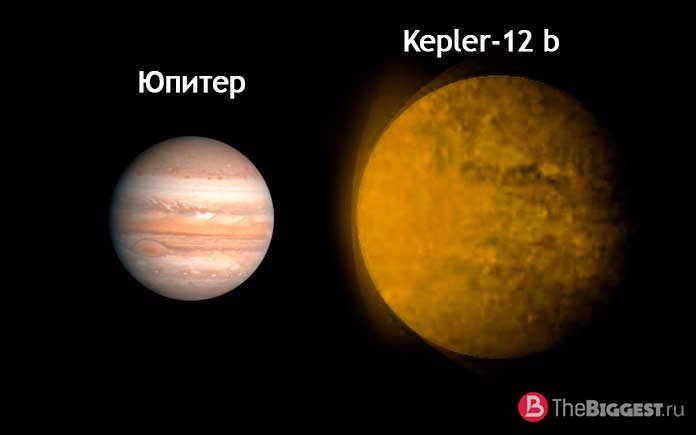
Beta Painter b
Here is yet another gas giant that revolves around its star in very close proximity (0.05 a.u.). Similar to numerous other planets in its class, this celestial body boasts an incredibly elevated surface temperature (1,481°K) and experiences inflation due to the force exerted by the solar wind.
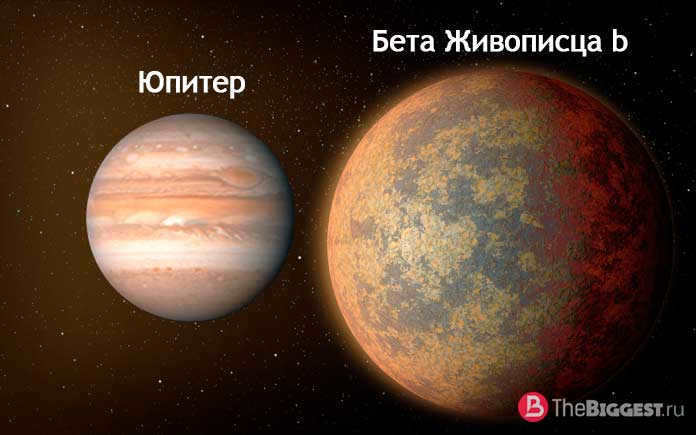
Let’s wrap up our article with a celestial body called Beta Painter b, which is situated in the Painter 63 sv constellation, approximately 9 astronomical units away from us. It has an orbital distance of 9 a.u., which is nearly twice the radius of Jupiter’s orbit and similar to that of Saturn’s orbit.
This colossal planet weighs 7 times more than Jupiter and boasts a radius 1.65 times larger than Jupiter’s radius.
The biggest planets in our solar system

The Largest Planet in the Solar System – Jupiter
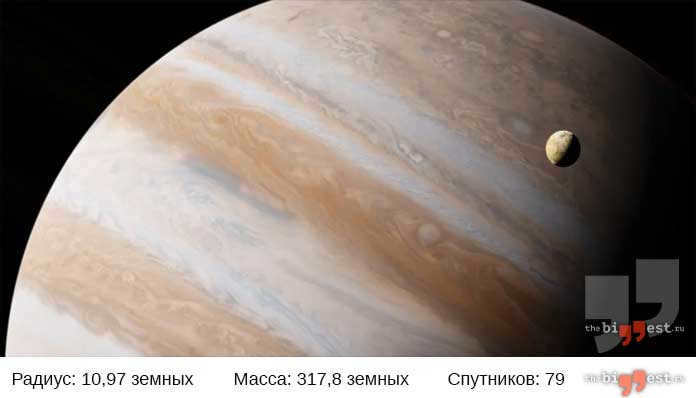
Let’s kick off the ranking with the 8th planet in our solar system, which takes the lead in terms of size and mass compared to its fellow orbiting planets.
Bearing the name of the Roman god of thunder, Jupiter holds the title for being the largest planet in our solar system. It surpasses Earth in diameter by a significant margin, measuring a whopping 139,822 kilometers.
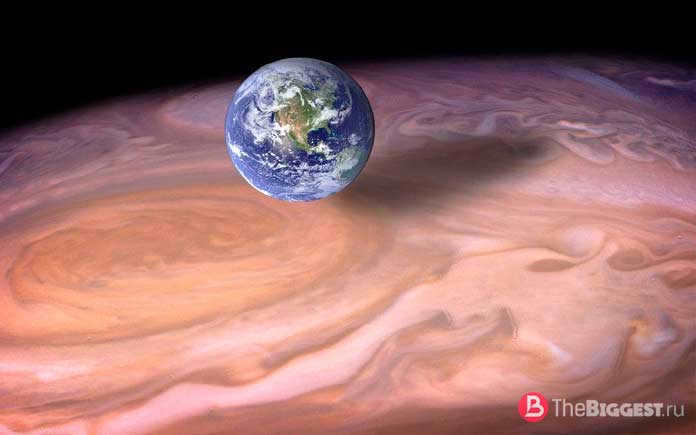
The image displays a comparison between the sizes of Jupiter and Earth
Jupiter, known for its powerful magnetosphere, is home to numerous satellites of varying sizes. Currently, the planet has 69 satellites, though due to its considerable distance from Earth, there is a possibility that some of Jupiter’s satellites are yet to be discovered.
Although Jupiter has a low density, its atmosphere, similar to Earth’s, is composed of multiple layers that exhibit different compositions and temperatures.
The planet Saturn
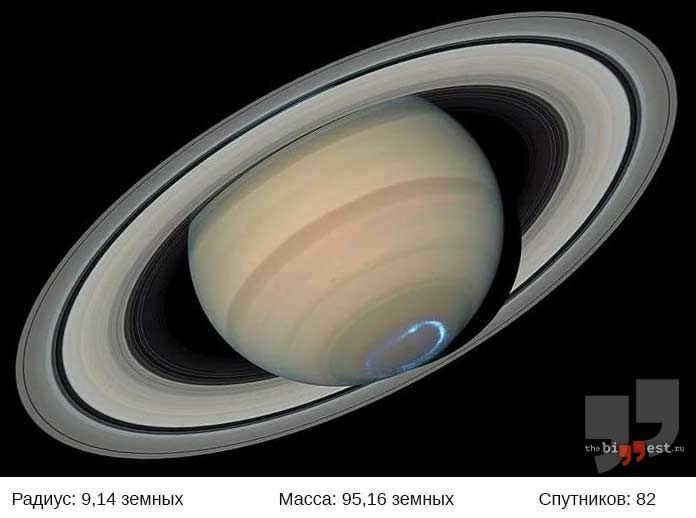
Saturn, similar to Jupiter, is not only one of the largest planets in our solar system but also one of the most stunning in the entire Universe. Its notable feature is the magnificent gas rings that are visible even through a modest telescope.
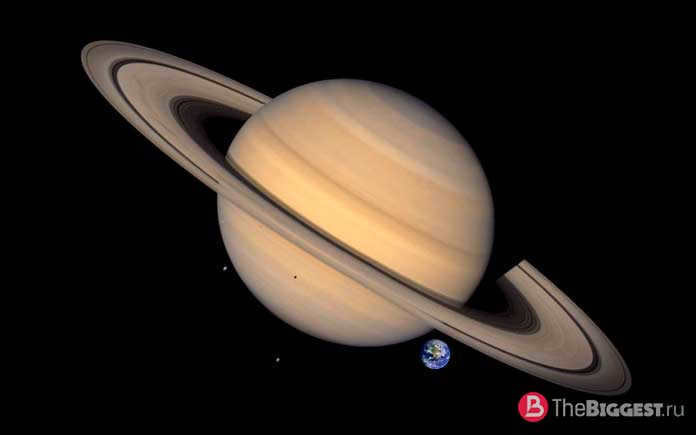
A picture shows the relative sizes of Saturn and Earth
Hydrogen is the main component of Saturn’s atmosphere, although helium and ammonia are also present. The planet’s upper atmosphere is known for its incredibly strong winds, which can reach speeds of up to 1,800 kilometers per hour.
Saturn is also home to a multitude of satellites, with a total of 82, 12 of which were discovered by spacecraft.

Did you know? An enormous enigma for researchers is the tempestuous weather phenomenon occurring at the pole of Saturn. When observed from outer space, it appears in the form of a massive and symmetrical hexagon.
Neptune
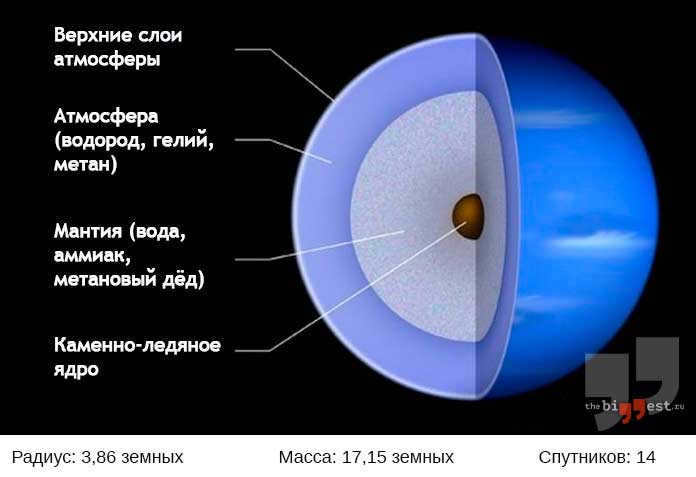
Neptune, a colossal gas planet, has a diameter of approximately 49,224 kilometers and is situated in the outermost region of the solar system, making it the planet with the farthest orbit from the Sun.
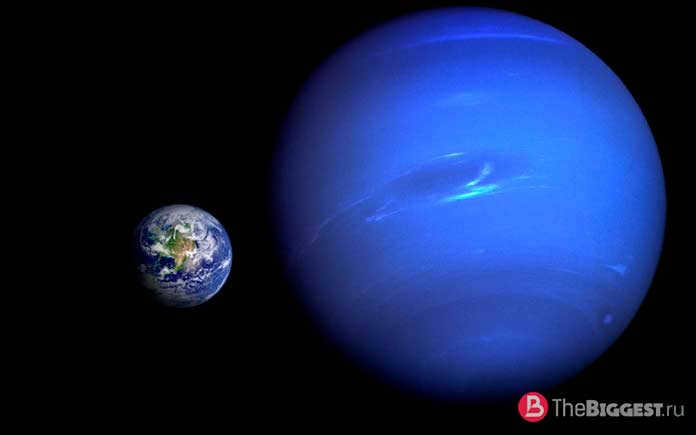
The photograph depicts the comparative size of Neptune and Earth
Consisting of a combination of solid rock and ice, Neptune is the most massive planet in the entire solar system, weighing 17 times more than Earth. Space stations that have been dispatched to the outer edges of our galaxy have captured the planet’s incredibly strong winds, which can reach speeds of up to 600 meters per second.
It is worth noting that astronomers were the first to calculate the orbit of Neptune, and by the end of the 19th century, it was possible to observe the planet through a telescope.
The planet Uranus
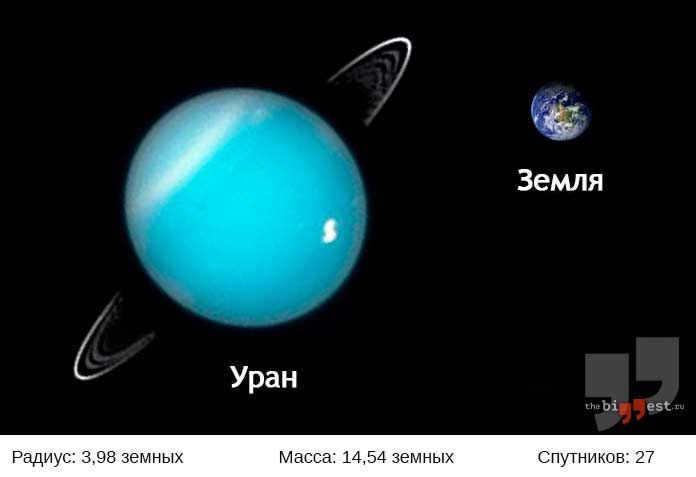
When it comes to volume, Uranus ranks third in the solar system, with a diameter of 50,724 kilometers. However, due to its low density, it holds the fourth spot in terms of mass.
What sets Uranus apart is its frigid temperature, making it the coldest among all the planets in orbit. It boasts a chilling temperature of -225°C.
In addition, Uranus boasts a set of faint rings, although they are not as prominent as those of its neighboring planets. Furthermore, it stands out as the only planet to be named after a deity from ancient Greece, rather than Rome.
Planet Earth
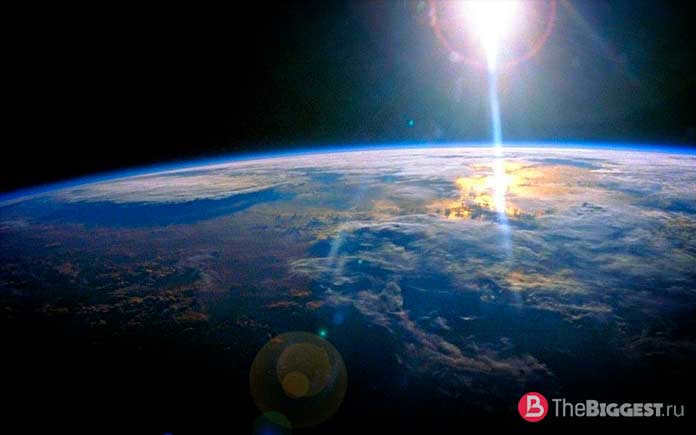
In the early Middle Ages, astronomers conducted studies on the parameters and characteristics of Earth, Venus, Mars, and Mercury to determine which planet in the Earth group is the largest.
Out of this group, Earth takes the undisputed lead, thanks to its favorable position in the Goldilocks zone, also known as the belt of life. If Earth were slightly closer to the Sun, water would vaporize, and if it were slightly farther away, water would freeze, making it impossible for life to exist. Scientists have calculated Earth’s mass to be 0.00315 times that of Jupiter’s mass.
Earth is currently the sole known planet in the universe to harbor life. Billions of years in the past, the planet’s surface gave rise to vast oceans, within which scientists believe life first originated.
Venus
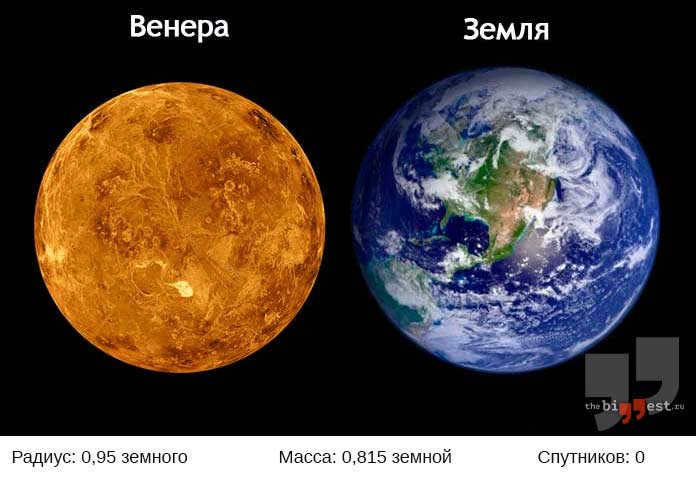
Comparison of Earth and Venus in terms of size
Venus and Earth are closely related, as they shared many similarities during their early formation stages. Venus was named after the ancient Roman goddess associated with love and beauty. These two neighboring planets share similar orbits and structures. However, there are significant differences in their atmospheres. Venus has a carbon dioxide-rich atmosphere instead of oxygen, and its clouds are composed of toxic compounds. Early researchers who observed Venus even believed that it experienced constant rainfall due to the presence of clouds.
There is continuous volcanic activity on Venus, resulting in a surface temperature of 475 ° C. Despite the high temperature, the planet remains relatively stable and not restless. The temperature difference on Venus’ surface is minimal, only varying by a few degrees. This phenomenon is attributed to the presence of the “greenhouse effect”.
Mars
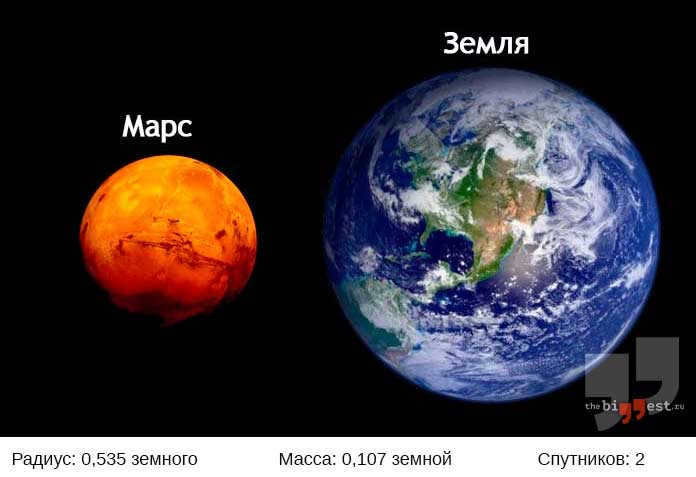
Seen here is a comparison of the sizes of Mars and Earth.
The Red Planet was named after the god of war and bears a resemblance to Earth on its rocky surface. However, Mars is devoid of water and life, despite numerous hypotheses and theories suggesting otherwise.
With a diameter of 6,780 kilometers, the temperature on Mars can range from -150 to +20°C at different times. The planet’s atmosphere consists mostly of carbon dioxide with traces of other substances, but does not contain any poisonous gases.
Due to the absence of a magnetic field, Mars’ surface is constantly exposed to solar radiation. Additionally, Mars holds two of the largest craters in the entire solar system.

Stunning images of the snow-covered landscape of Mars were released by NASA in December 2017. It has been discovered that the frigid temperatures at the planet’s poles cause the carbon dioxide in Mars’ atmosphere to solidify and fall as snow onto the surface.
Mercury
Mercury is the smallest and closest planet to the Sun in the Solar System. It is named after the Roman god of commerce, travel, and thievery. Mercury has a surface that is heavily cratered and is covered in a layer of fine dust and rocky debris. The planet has a thin atmosphere that is composed mainly of helium and traces of sodium and potassium. Mercury has a highly elliptical orbit around the Sun, which causes extreme temperature variations on its surface. During the day, temperatures can reach up to 800 degrees Fahrenheit, while at night, temperatures can drop to -290 degrees Fahrenheit. Despite its close proximity to the Sun, Mercury does not have an atmosphere thick enough to retain heat, so its surface temperatures can be extreme. The planet has no moons or rings and is not known to have any evidence of life. Scientists have sent several missions to Mercury to study its geology, magnetic field, and atmosphere. These missions have provided valuable insights into the formation and evolution of the planet.

The smallest planet closest to the Sun, with a diameter of 4,879 kilometers, bears a resemblance to Earth’s natural satellite, the Moon, due to its abundance of craters and rocky surface.
Mercury experiences extreme temperatures, reaching up to +425 degrees on its sun-facing side and dropping to -175°C at night.
Recent research indicates the presence of large ice formations, mixed with ash and dust, at the planet’s poles. This is attributed to the areas where sunlight does not reach.
Allow me to sum up

Actually, there are still a great number of planets we would like to inform you about. If you found this article enjoyable and wish to learn more, please feel free to leave a comment and we will gladly provide you with additional information.
Not too long ago, TheBiggest.ru has already covered the topic of the largest stars in the Universe. You can take a look at it, as it is a highly engaging article.
Furthermore, we have compiled some more fascinating facts about planets below.
Fascinating information about the planets
- Jupiter functions as a protective barrier, safeguarding the Earth from comets and other celestial objects entering our solar system. Its powerful gravity attracts them.
- Jupiter is also the speediest in its rotation on its axis. In comparison to Earth, it completes one rotation in just 12 hours.
- Our planet Earth is the only one that is not named after a deity from ancient Greek or Roman mythology.
- Olympus Mons, a volcano situated on the surface of Mars, is the largest among the currently observed similar features in the universe. Its peak is located 27 kilometers above the reddish Martian surface.
- Although Mercury’s orbit is nearly perpendicular to the plane of rotation of our star, which logically suggests that there should be no change of seasons on the planet, its orbit is actually highly elongated. As a result, Mercury alternates between approaching the Sun at a distance of 46 million kilometers and moving away from it at a distance of 70 million kilometers. It is this variation in distance from the Sun that gives rise to the seasons on Mercury.
- On Earth, however, the seasons are determined by the tilt of the planet’s axis rather than its distance from the Sun. This means that during winter, the Earth is actually closer to the Sun than it is during summer.
Concluding, it is worth mentioning that our Milky Way, along with smaller neighboring galaxies, functions as satellites of a larger galaxy. However, there is currently an ongoing process of assimilation by the Milky Way of the Dwarf Sagittarius Galaxy, which had been our satellite for millions of years.
Many of the planets we are aware of have been known to humanity since ancient times. From the moment of their discovery, they have served as objects of worship, religious beliefs, and have seamlessly integrated into the mythologies, legends, and religions of numerous peoples around the world. The editorial team at TheBiggest eagerly awaits your comments. We have a particular interest in the topic of space, so feel free to write to us and share your thoughts and knowledge.
Note from the editor: This article has been updated since its initial publication in January 2018.
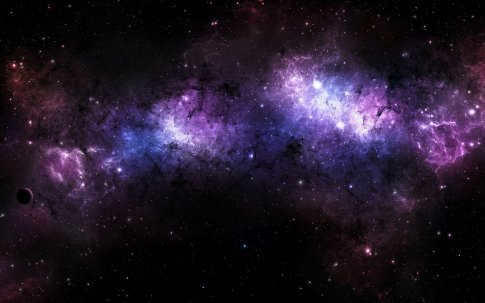
Our universe is vast, however, many individuals hold the misconception that nothing can be larger than Earth. Regrettably, this notion is deeply flawed. In addition to our planet, there exist countless others that are beyond our wildest imagination. With the aid of advanced telescopes, we are able to observe a fraction of these celestial bodies, which are located thousands of light years away from us.
Stunning revelation
During the early months of 2006, a groundbreaking discovery was made by scientists that has the potential to revolutionize the way we perceive celestial entities. In the United States, situated within the state of Arizona, a renowned observatory became the epicenter of this remarkable finding. Here, scientists meticulously scrutinized the constellation Hercules, only to be astounded by the presence of an enormous planet concealed within. This celestial body surpassed the size of our Earth by a factor of twenty, making it the largest known planet to mankind. Despite its resemblance to our Sun in terms of scorching temperature, it unequivocally remains a planet in its core.
TrES-4
is a unique exoplanet that has captured the attention of scientists. This remarkable planet is known for its enormous size and low density, making it one of the largest known exoplanets. TrES-4 is located approximately 1,430 light-years away from Earth and has a radius about 1.7 times that of Jupiter. Its low density suggests that it has a large atmosphere, possibly composed of light gases such as hydrogen and helium. The discovery of TrES-4 has provided valuable insights into the diversity of exoplanets and the incredible range of planetary systems that exist in our universe.
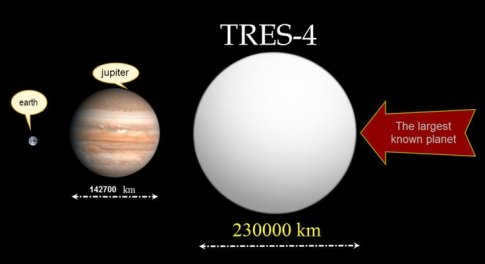
The name given to this celestial body is TrES-4. Scientists have made a fascinating discovery that TrES-4’s size can surpass that of Jupiter, the largest planet in our solar system, by almost double. TrES-4 is primarily composed of hydrogen and is a gaseous sphere at its core. Located 1,400 light-years away from Earth, this planet continuously orbits around our planet.
The complexities of TrES – 4, an exoplanet
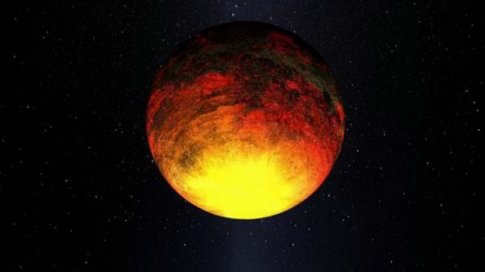
Thanks to the thorough investigation carried out by scientists, it has been discovered that the surface temperature of the largest planet is approximately 1260 degrees. There may exist larger planets within the vast universe. Nevertheless, as of now, TrES – 4 undeniably holds the title of being the largest planet. This colossal gas giant could easily be mistaken for a mere star, but upon closer examination, it became evident that it revolves continuously around its own star, a characteristic exclusive to planetary entities.
Scientists have reached a unanimous agreement that the composition of the planet is predominantly gaseous rather than possessing a solid surface. The notion of successfully landing a spacecraft on it is simply unattainable. The likelihood of approaching the planet at its closest proximity is quite slim. However, in the event that one does manage to devise such a model, it would essentially be absorbed into the core of the planet. The maximum density of the planet is approximately 0.2 grams per cubic centimeter. This density can only be likened to that of a cork tree which thrives on the Earth’s surface.
Scientists have yet to provide a definitive explanation for the existence of a planet in the universe with such a remarkably low density. This particular planet, known as TrES-4 or TrES-4b, was discovered thanks to the dedicated work of amateur astronomers. Using a coordinated network of small telescopes, located in both Arizona and the Canary Islands, these astronomers were able to make this astounding discovery.
The movement of the biggest planet
